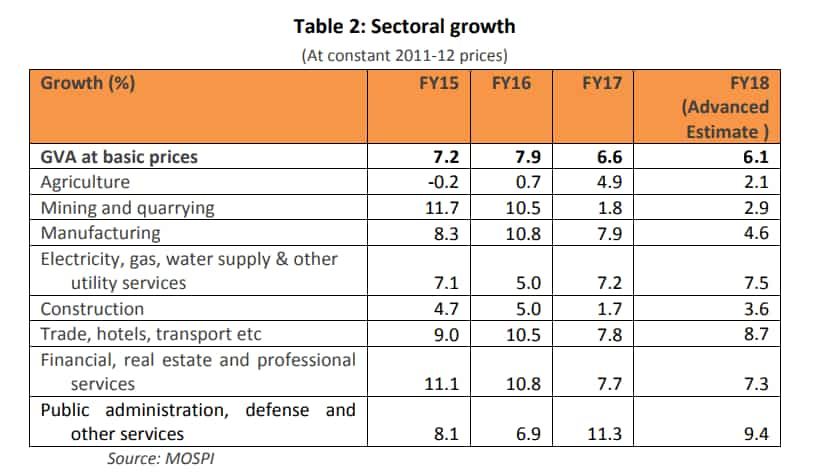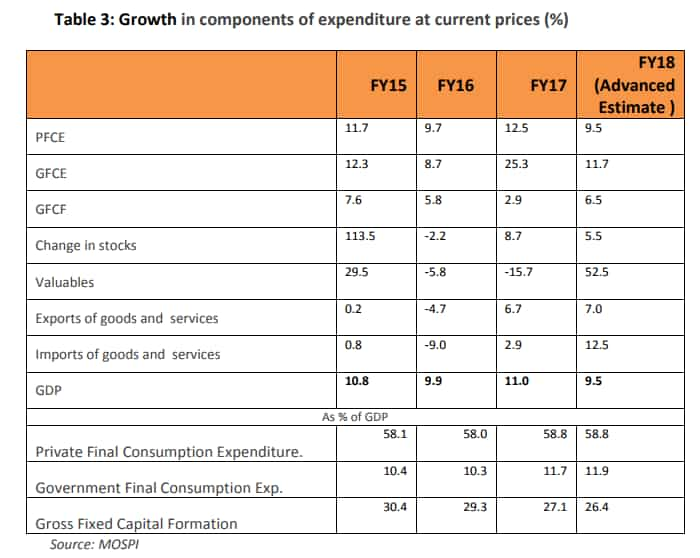Indian economy's four-year low data surprise experts, analysts
GDP numbers stood at 6.3% in the second quarter of FY18 (Q2FY18) from 5.7% in the preceding quarter.

The first advance estimate for Indian economy, at four-year low, is surprisingly lower than even what analysts and experts are forecasting for the country.
According to the the Central Statistics Office (CSO) report, real GDP or Gross Domestic Product (GDP) to attain a level of Rs 129.85 lakh crore in the year 2017-18, as against provisional estimate of Rs 121.90 lakh crore for 2016-17.
The estimated growth rate of 6.5% for 2017-18 versus 7.1% in 2016-17 for India's GDP, however, has been predicted at four-year low by Care Ratings.
Even Gross Value Added (GVA) is anticipated at Rs 118.71 lakh crore in 2017-18 as against Rs 111.85 lakh crore in 2016-17, having a growth rate of 6.1% in 2017-18 from 6.6% in 2016-17 - at a three year low.
When India's GDP numbers came in at 6.3% in the second quarter of FY18 (Q2FY18) from 5.7% in Q1FY18, experts were not convinced that the country's economy is moving on a sustainable path.
source: tradingeconomics.com
It may be noted here that forecasts of Fitch Ratings, CRISIL, Care Ratings and even of RBI are not that lower compared to what the CSO predicted for Indian economy.
Fitch Ratings believes that Indian economy will grow at 6.7% in FY18 from earlier 6.9% citing weaker than expected rebound.
CRISIL too has projected India's GDP at 6.8% with downside bias from previous 7% for FY18.
CARE Ratings' estimated that GDP growth would be in the range of 6.7-6.8% for the year.
The CSO's GVA forecast, however, is even lower than the RBI’s estimate of real GVA growth of 6.7% for the fiscal.
Madan Sabnavis and Kavita Chacko, economists at Care Ratings, said, "The difference between the GDP and GVA in FY18 is estimated to be only marginally lower (at 0.4%) than that in FY17 (0.5%)."
"This means that although the GST collections so far (till DEc’17) have not been very encouraging, the government expects the tax collections to improve for the remainder of the fiscal and to be fairly in line with the total collections of last year," the duo added.
They further said, "The slowdown in the Indian economy in FY18 is estimated to be fairly broad based with agriculture, manufacturing and services such as financial, real estate & professional services along with public administration and social services are expected to see a moderation in growth rates."

Dr Soumya Kanti Ghosh, Group Chief Economic Adviser at State Bank of India, however, said, "This estimate however has a shelf-life of only two months. This is because CSO will release the first revised estimate of FY15, FY16 and FY17 on 31 Jan’18 and based on that estimate of GDP and GVA for FY18 would be revised further as 2nd advance estimate for FY18 on 28 Feb’18."
Ghosh also pointed out that projections for H2FY18 reveal that CSO is not expecting a big jump in demand.
Citing similar reason, Care Ratings also believe that private consumption is expected to grow lower rate in FY18 – somewhat 3% lower than previous year.

The investment rate measured as the ratio of gross fixed capital formation to GDP at current price will also decelerate to 26.4% in FY18 from 27.1% in FY17 and 34.3% in FY12.
Care said, “This indicates that corporate have not been investing in capital creation this year. A pick up private investment is essential for a rise in overall investment rate.”
Private final consumption expenditure gradually decelerated to 6.5% in Q2FY18 from 6.7% in Q1FY18 and 7.9% in Q2FY17. This indicator accounts 57.3% of GDP this quarter and has remained muted at this level in the last one year.
Interestingly, government's final consumption expenditure also fell to a single-digit at 4.1% this quarter from 17.2% in Q1FY18 – holding 13.5% of GDP. Slower growth in the government spending has been reflected in both GVA and GDP growth figures.
Care also believes that exports are expected to see a marginal improvement this fiscal, but warns that imports are expected to see a notable improvement.
With this, for FY18, the budgeted nominal GDP growth rate was 11.75% which has now been revised down to 9.5. Based on this, Ghosh states that the government will overshoot it's fiscal deficit target by 5 basis points this fiscal.

Nevertheless, the forthcoming budget is seen to provide better picture to the government's focus.
Ghosh said, “We don't rule out unveiling of a major agri push in budget in the form of price support scheme for farmers that could have a fiscal implication, but eminently good for growth.”
“Government will continue thrust on infrastructure developments in the country. So, we believe construction sector will expand at a faster pace in next fiscal,” he added.
Bank of America Merill Lynch (BofA-ML) report stated that growth will inch up to 7.2% in 2018-19 (and 7.6% in 2019-20) from 6.5% in 2017-18, to be driven by consumption, supported by a pre-poll step up in public spend rather than investment, given the persistence of surplus capacity.
Analysts at Nomura and Morgan Stanley stated that Indian economy can be expected to grow at 7.5% rate in 2018, as they expressed confidence about prospects for a recovery in private capital spending as demand conditions are improving post demonetisation and GST implementation.
Get Latest Business News, Stock Market Updates and Videos; Check your tax outgo through Income Tax Calculator and save money through our Personal Finance coverage. Check Business Breaking News Live on Zee Business Twitter and Facebook. Subscribe on YouTube.
RECOMMENDED STORIES

Small SIP, Big Impact: Rs 1,111 monthly SIP for 40 years, Rs 11,111 for 20 years or Rs 22,222 for 10 years, which do you think works best?

SBI 444-day FD vs PNB 400-day FD: Here's what general and senior citizens will get in maturity on Rs 3.5 lakh and 7 lakh investments in special FDs?

Looking for short term investment ideas? Analysts suggest buying these 2 stocks for potential gain; check targets

Power of Compounding: How long it will take to build Rs 5 crore corpus with Rs 5,000, Rs 10,000 and Rs 15,000 monthly investments?

SCSS vs FD: Which guaranteed return scheme will give you more quarterly income on Rs 20,00,000 investment?
01:16 PM IST









 India's GDP expected to fall below 6.5% in FY25 amid slowdown in GDP growth in second quarter: SBI
India's GDP expected to fall below 6.5% in FY25 amid slowdown in GDP growth in second quarter: SBI $8 trillion of $14 trillion invested in India since 1947 came in last 10 years
$8 trillion of $14 trillion invested in India since 1947 came in last 10 years India's GDP growth likely to slip at 6.5%, maintains 7% estimate for FY25: Icra
India's GDP growth likely to slip at 6.5%, maintains 7% estimate for FY25: Icra IMF says India's GDP growth to moderate to 7% in 2024 and 6.5% in 2025
IMF says India's GDP growth to moderate to 7% in 2024 and 6.5% in 2025  India to clock GDP growth of 7% in FY25: NITI Aayog member
India to clock GDP growth of 7% in FY25: NITI Aayog member